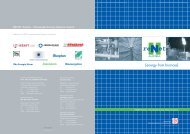K u rzfassu n g sb an d - Graz University of Technology
K u rzfassu n g sb an d - Graz University of Technology
K u rzfassu n g sb an d - Graz University of Technology
- Keine Tags gefunden...
Erfolgreiche ePaper selbst erstellen
Machen Sie aus Ihren PDF Publikationen ein blätterbares Flipbook mit unserer einzigartigen Google optimierten e-Paper Software.
80 Energieinnovation 2006<br />
3.4.4 „Hydro-Thermal Optimal Scheduling Using Decomposition<br />
Approach“<br />
Cherry Yuen, (ABB Schweiz), Gertrud Rossa (TU-<strong>Graz</strong>)<br />
The study focuses on the long-term scheduling problem <strong>of</strong> hydro-thermal energy resources in big<br />
systems. The challenge <strong>of</strong> such problems is the size <strong>of</strong> the optimization problem, mainly caused by the<br />
stochastic nature <strong>of</strong> certain exogeneous variables, such as water inflow, energy dem<strong>an</strong>d, etc.<br />
However, such problems also naturally involve multiple stages, e.g. twelve months in a year. For<br />
pl<strong>an</strong>ning purposes, one needs to work out the optimal usage <strong>of</strong> different resources in the system, so<br />
that the total cost over the whole study period, e.g. one year, is minimized. The multi-stage problem,<br />
with various scenarios to represent the possible combinations <strong>of</strong> values <strong>of</strong> the stochastic exogeneous<br />
variables, c<strong>an</strong> be formulated as one linear-programming (LP) problem. However, depending on the<br />
available LP solver <strong>an</strong>d the processing power <strong>of</strong> the computer, the so-formulated problem c<strong>an</strong> take a<br />
very long time to solve, even for a commercial solver. In some cases, due to excessive memory<br />
requirements, the problem c<strong>an</strong>not even be solved. For example, in a big system with several hundred<br />
reservoirs <strong>an</strong>d a hundred scenarios, that c<strong>an</strong> result in a LP problem with a million variables <strong>an</strong>d<br />
number <strong>of</strong> constraints in the same magnitude.<br />
To overcome this, one c<strong>an</strong> decompose the problem into multiple single-stage subproblems, each <strong>of</strong><br />
them is much smaller th<strong>an</strong> the original problem <strong>an</strong>d is therefore much faster to solve. The principle is<br />
well-known <strong>an</strong>d is called Benders Decomposition. The information in between stages is tr<strong>an</strong>smitted<br />
from one stage to <strong>an</strong>other by the use <strong>of</strong> Benders Cuts. These Benders Cuts form a convex piecewise<br />
linear function which represents the approximated future cost function, which is added to the singlestage<br />
subproblem so that the present cost c<strong>an</strong> be optimized with the consideration <strong>of</strong> the future<br />
stages. Despite <strong>of</strong> slow convergence for certain cases, this approach has proven to be performing<br />
satisfactorily.<br />
In the stochastic decomposition approach, a set <strong>of</strong> scenarios are used for stochastic optimization to<br />
obtain the optimal solution. These scenarios are generated using Monte Carlo simulations. The results<br />
so obtained are better th<strong>an</strong> those obtained when <strong>an</strong> averaged scenario based on all the scenarios is<br />
fed in a deterministic formulation. The stochastic future cost function is also a piecewise linear function<br />
which is a weighted average representation <strong>of</strong> the Benders Cuts <strong>of</strong> all the scenarios. The results<br />
based on several numerical examples are illustrated in the presentation.





